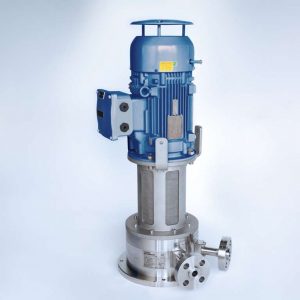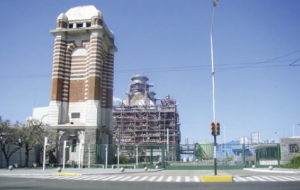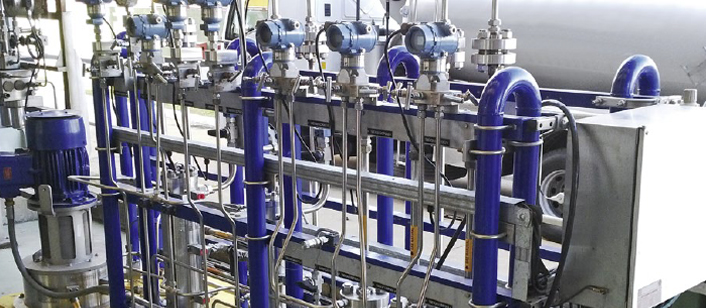What is the RoTechBooster by EagleBurgmann?

Features of the RoTechBooster
- Electric driven centrifugal design
- Hermetically sealed
- Delivers seal gas flow as defined by API
- 24,000 hours of operation before required maintenance
- Various models available, depending on requirements
Advantages of the RoTechBooster
- Simple to set-up, easy to operate
- High reliability and availability
- Unlimited continuous operation
- Avoid seal failures
- Low maintenance costs
- Energy efficient
- Eliminates the concern of unreliable external seal gas source
RoTechBooster Case Study: Clean Gas Despite Fluctuating Operating Conditions
The "Dock Sud“ combined power cycle plant in Buenos Aires, Argentina, is designed to adjust the power generation to the fluctuating electrical demand throughout all seasons. Managing the high demand during the summer months is particularly challenging, and the requirements for system component reliability are correspondingly high.

The power plant uses diesel engines and gas turbines to drive the generators. The diesel-driven generators run on a regular basis. The gas turbines are operated in start/stop mode so that they can respond quickly to high energy requirements or cope with peak loads.
As a low-pressure gas supply for the plant was only available to use for the gas turbines, a MAN Diesel & Turbo four-stage geared compressor with dry gas seals provided the means to increase gas pressure to the appropriate level for them. There is one geared compressor for each of the two gas turbines on site. Another geared compressor is used as back-up. Due to the nature of the operation, the turbines stop and start frequently placing the geared compressors in a pressurized stand-by mode when electrical demand drops.
Harsh conditions in stand-by mode
In the past, the compressors had been equipped with a competitor‘s gas-lubricated seals. Harsh conditions were produced for the dry gas seals when the compressor stopped, placing it in a pressurized hold and losing seal gas supply flow.
Some seals operated for ten years before failure. However, most seals were failing in less than three years and even became more frequent resulting in failures in less than one year. Amongst these seal failures were a number of catastrophic seal failures causing severe damage to the compressor, and allowing process gas leaks to atmosphere. Over the years, oil and debris from reciprocating compressors and equipment with oil seals has increased the contamination in the line, which has also added to the frequency of the seal failures.
The ultimate reason for the seal failures was process contamination, which happened because there was no clean seal gas flow to the seals. The presence of contamination in the process gas became more prevalent due to equipment in the gas supply pipeline for the plant.
Consequences of changed pressure conditions
Under normal operating conditions, conditioned gas from the discharge of the compressor supplies the dry gas seals. Since the dry gas seals operate at a pressure below discharge, the gas will flow through filters and into the seal cavity producing a clean dry environment for reliable seal operation.
When the compressor is shut down, there is no differential pressure between the compressor discharge and the seal cavity. Therefore, a clean dry seal environment cannot be maintained. As the clean gas in the seal cavity slowly leaks through the seal, dirty gas from the process replaces it. Eventually the dirty process gas leaks through the seal, contaminating the seal faces and the dynamic sealing element. When the compressor starts, this contamination damages the seal faces or prevents the seal faces from moving freely, leading to seal failures.
Another situation that allows process gas into the seal cavity is through pressurization: when the pressure in the compressor changes, such as pressurizing the compressor or a pressure increase in the plant supply pipeline, it causes dirty process gas to enter the seal cavity. When a pressure increase occurs, the gas in the seal cavity compresses, and available space fills with contaminated process gas. This can push dirty process gas all the way up into the supply line for the seal, but as a minimum contaminates the seal cavity and seal faces with dirty process gas. With a dirty seal cavity and contaminated seal, a seal failure is imminent.
In this case, incorporating a system to ensure seal gas flow prevents dirty process gas from entering the seal cavity during these situations.
RoTechBooster ensures clean gas supply
The operator of the Dock Sud power plant realized that the seals needed clean gas. He reviewed the available equipment and selected the EagleBurgmann RoTechBooster system which reliably supplies the seals with gas even under fluctuating operating conditions. It was the low maintenance requirements, high functional reliability and low life cycle costs that was particularly convincing.

The requirement was to supply clean gas to twelve seals of the three compressors. A standard RoTechBooster model was modified for this purpose. In cooperation with EagleBurgmann, the power plant operator Central Dock Sud S. A. developed a system that provides a flexible supplemental gas flow rate when the number of compressors in standby mode increases. Keeping safety in mind, the design allows the isolation of any single compressor from the process to ensure accessibility when compressor maintenance is required. It also ensures seal gas flow to each compressor when pressurized and sufficient discharge pressure is not present to produce seal gas flow.
The plant operator also replaced in one compressor the existing seals with four EagleBurgmann PDGS10 Dry Gas Seals (design pressure: 122 barg (1.769 PSIG), design temperature: -20 °C … +200 °C (-4 °F … +392 °F). Thanks to features in the EagleBurgmann seal, it can manage contamination more effectively and should a seal failure occur, it will not cause damage outside the seal cartridge due to special materials used for the seal faces.
Gas supply controlled with smart logic
The gas supply system is controlled electronically. The most essential components are a programmable logic controller (PLC), a frequency converter, several flow indicator transmitters and pneumatically operated ball valves. When the compressor is pressurized, the PLC controls the system to ensure sufficient flow of seal gas to the dry gas seals. When seal gas flow is required, the PLC energizes the solenoids to open the valves for a specific compressor and turns on the RoTechBooster to deliver seal gas flow to the compressor.
The flow indicator transmitter measures the seal gas flow to the compressor and sends a signal indicating the measured flow to the PLC. The PLC then signals the frequency drive to increase or decrease speed of the RoTechBooster to deliver the needed seal gas flow.
If another compressor stops or is pressurized, the PLC opens the appropriate valves and signals the frequency drive to speed up the motor as the demand for flow has increased. The reverse occurs when the compressor starts or depressurizes.
RoTechBooster Successful in Operation
Full operation of the RoTechBooster system started with the completed commissioning in September 2016, when the RoTechBooster operated as the last compressor came back on line. To date, the system delivers seal gas flow as required for all compressors and the seals have a steady leakage rate; indicating no seal contamination.
This is just another case to support how ensuring clean seal gas supply will increase dry gas seal reliability, delivering increased uptime and profits from a more reliable compressor.
Gallagher Seals is a preferred distributor of EagleBurmann mechanical seals and products.
For more information about the RoTechBooster and how it can help provide abundant, clean, and dry gas flow, contact Gallagher Fluid Seals today.
